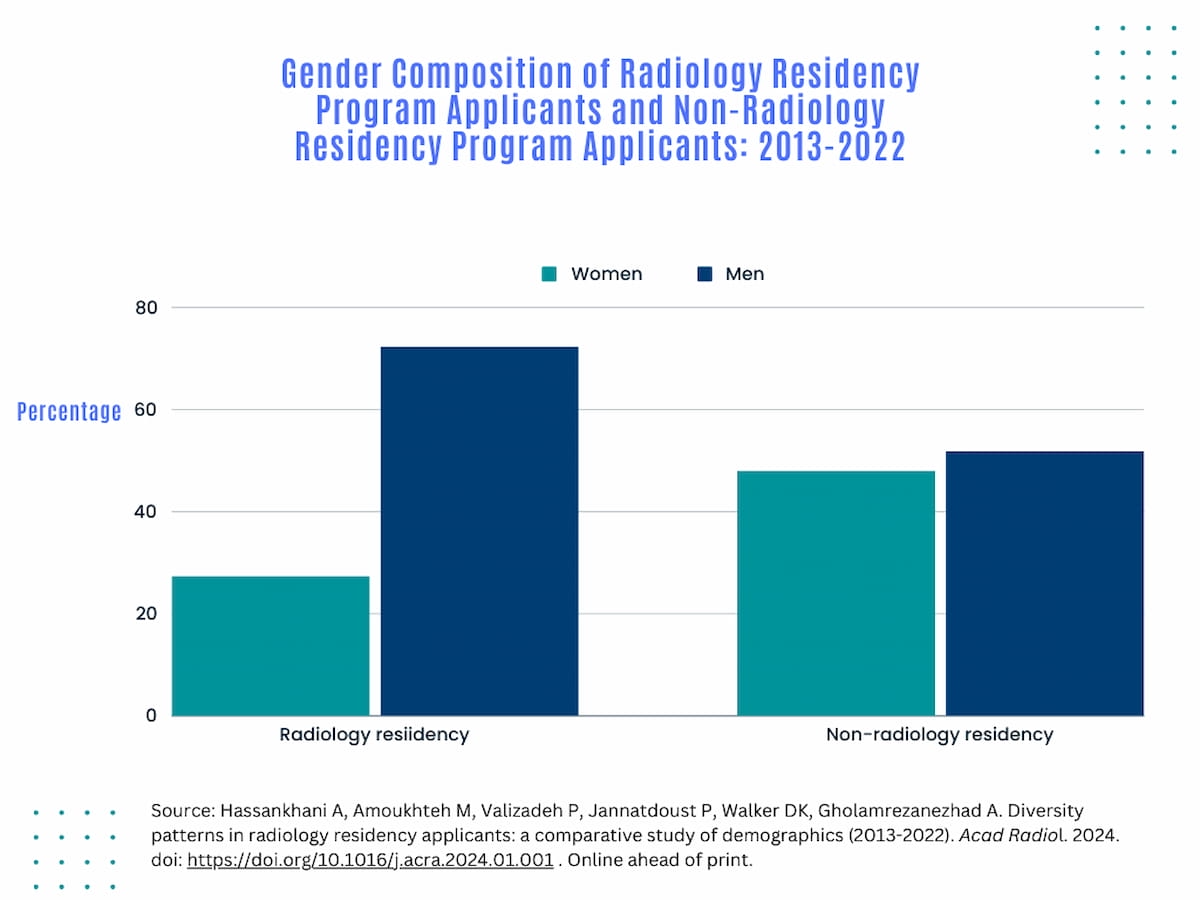While women comprised nearly half of the applicants to residency programs between 2013 and 2022, new research shows that female applicants accounted for slightly over a quarter of applicants to diagnostic and integrated interventional radiology residency programs over the same time period.
For the demographic study, recently published in Academic Radiology, researchers reviewed aggregate data from the Electronic Residency Application Service (ERAS) to examine the gender, racial and ethnic composition of United States diagnostic and integrated interventional radiology residency program applicants in contrast to applicants for non-radiology residency programs between the years of 2013 and 2022.
The researchers found that 27.63 percent of radiology residency program applicants were women in comparison to 48.08 percent of non-radiology residency program applicants.
In other demographic findings from the research, the study authors found that international medical graduates (IMGs) comprised 33.54 percent of radiology residency program applicants in comparison to 40.67 percent of applicants to non-radiology residency programs.
The study authors also noted a smaller percentage of African American applicants (5.74 percent vs. 7.13 percent) as well as a smaller proportion of Hispanic, Latino and Spanish origin applicants (7.3 percent vs. 8.47 percent) among radiology residency program applicants in comparison to non-radiology residency program applicants.
“These findings underscore the importance of implementing focused interventions to bolster diversity and inclusivity within the realm of radiology. It is imperative to expand outreach and mentorship initiatives for individuals from underrepresented backgrounds,” wrote study co-author Ali Gholamrezanezhad, M.D., the director of clinical research within the Department of Radiology at the Keck School of Medicine at the University of Southern California (USC), and colleagues.
Three Key Takeaways
- Gender disparity in radiology residency applications. The study reveals a significant gender gap in applicants to diagnostic and integrated interventional radiology residency programs, with only 27.63 percent of applicants being women, compared to 48.08 percent in non-radiology residency programs between 2013 and 2022.
- Underrepresentation of certain ethnicities in radiology. The research highlights disparities in racial and ethnic composition among radiology residency program applicants. African American applicants constitute 5.74 percent, and Hispanic, Latino, and Spanish origin applicants make up 7.3 percent, both lower than their counterparts in non-radiology residency programs.
- Call for diversity and inclusivity interventions in radiology. The study emphasizes the need for targeted interventions to enhance diversity and inclusivity in radiology. The authors propose strategies such as tailored educational programs for early exposure to radiology, promoting diversity in leadership roles, and addressing potential issues related to gender discrimination to attract a more diverse pool of applicants to radiology residency programs.
Potential interventions to foster increased applicant diversity may include tailored educational programs to facilitate early exposure to radiology, encouraging diversity in leadership, and addressing possible issues related to gender discrimination, according to the study authors.
(Editor’s note: For related content, see “Diversity and Radiology: Where Things Stand,” “Nine Takeaways from New Article Examining Health Equity in the Radiology Field” and “The Opportunities, Responsibilities and Challenges for Women in Radiology.”)
The researchers noted that radiology residency programs had higher percentages of Asian applicants (23.69 percent) and American Indian or Alaska native (AIAN) applicants (0.70 percent) than non-radiology residency programs (22.66 percent and 0.52 percent respectively).
In regard to study limitations, the authors pointed out that that ERAS dataset included applicants who applied to multiple residency programs and lacks clarity as to what residency program they were accepted to. Gholamrezanezhad and colleagues also acknowledged a lack of specific gender, race, and ethnic demographic statistics specific to IMGs and United States medical graduates (USMGs).
